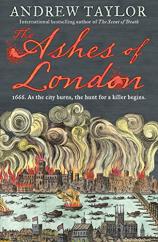The Ashes of London
Review
The Ashes of London
The Great Fire of 1666 swept through London over a period of three days. While there is no available estimate as to the number of lives lost in this huge conflagration, there is a record of the physical damage that was caused. The major casualties of the fire were St. Paul's Cathedral and the Medieval city of London --- a replica of old Rome and the Roman Empire.
Award-winning British author Andrew Taylor has taken this tumultuous event and used it as the backdrop for his latest historical thriller. THE ASHES OF LONDON finds James Marwood on a mission for the British government to track down a killer. It seems that among the ashes and rubble of the fire, two separate bodies were found. Evidence on the corpses, including stab wounds, showed that each man was a murder victim and had not been killed by the fire.
While Marwood goes through the paces of his mission, we are introduced to a secondary character. Catherine, or “Cat,” is on her own private mission, that of vengeance. Her recent past has been marred by personal tragic events, and her goal is to pose as a housemaid in an effort to infiltrate and take down those who did her wrong.
"THE ASHES OF LONDON does not move like a raging fire. Rather, Taylor has infused this lengthy tale with enough characters and ominous atmosphere that the story consistently plays out like a classic whodunit."
The Great Fire was tied to a baker's shop deep in the heart of the old city, and destruction followed its path through the surrounding area. Those who experienced the fire firsthand described it as a beast with an audible growl. This called to mind moments in the great Ron Howard film Backdraft, where raging fires were treated like a living evil being bent on complete destruction.
With the sun all but blotted out by the smoke and ash, Marwood moves forward through the darkened city with his assignment. The two murder victims show signs of blows to the head along with stab wounds, but this does not provide Marwood with enough evidence to build a decent murder case or identify any suspects. Instead, he needs to delve into the backgrounds of the victims, and find out who they might have in common and what enemies they may have made. The second victim was not found until six weeks after the first, and Marwood realizes that more victims and possibly some valuable evidence may still be buried beneath the ash of the Great Fire.
Of course, the paths of Marwood and Cat will eventually cross, and we see this first meeting nearly halfway through the novel. Cat is committed to her own plans but realizes that her family is forcing her into an engagement while blackmailing her with threats of turning her in for the attempted murder of one of her cousins. One of the victims, a man named Layne, was tied to some of the people in Mistress Alderley's circle. It is the Mistress who Cat had specifically targeted in her revenge plot.
Mistress Alderley even goes so far as to paint a picture of Cat to Marwood that makes her out to be a strange, dark girl who has the potential to commit murder and other horrible crimes. The list of characters and murder suspects is endless. At times I wished I had a glossary of characters to keep everyone straight. I particularly enjoyed the interjection of actual historical figures like King Charles II, Marwood's employer Williamson and Dr. Christopher Wren. I found it ironic that Wren was part of the crowd at Alderley manor, especially considering he shares the same name as a character from Dame Agatha Christie's classic play and story, "The Mousetrap."
THE ASHES OF LONDON does not move like a raging fire. Rather, Taylor has infused this lengthy tale with enough characters and ominous atmosphere that the story consistently plays out like a classic whodunit. It moves along in a slow burn with each chapter turning up more clues. The eventual head-to-head meeting of Marwood and Cat is set up nicely, and the denouement is well worth the effort and wait.
Reviewed by Ray Palen on May 12, 2017
The Ashes of London
- Publication Date: March 28, 2017
- Genres: Fiction, Historical Fiction, Historical Thriller, Suspense, Thriller
- Hardcover: 496 pages
- Publisher: HarperCollins
- ISBN-10: 0008207755
- ISBN-13: 9780008207755





